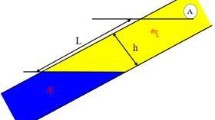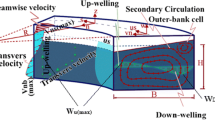Abstract
Dimensional analysis and numerical simulations were carried out to research prediction method of breakthrough time of horizontal wells in bottom water reservoir. Four dimensionless independent variables and dimensionless time were derived from 10 influencing factors of the problem by using dimensional analysis. Simulations of horizontal well in reservoir with bottom water were run to find the prediction correlation. A general and concise functional relationship for predicting breakthrough time was established based on simulation results and theoretical analysis. The breakthrough time of one conceptual model predicted by the correlation is very close to the result by Eclipse with less than 2% error. The practical breakthrough time of one well in Helder oilfield is 10 d, and the predicted results by the method is 11.2 d, which is more accurate than the analytical result. Case study indicates that the method could predict breakthrough time of horizontal well under different reservoir conditions accurately. For its university and ease of use, the method is suitable for quick prediction of breakthrough time.
Similar content being viewed by others
References
JOSHI S D. Horizontal wells: Successes and failures [J]. Journal of Canadian Petroleum Technology, 1994, 33(3): 15–17.
CHAPERON I. Theoretical study of coning toward horizontal and vertical wells in anisotropic formations: Subcritical and critical rates [C]// SPE Annual Technical Conference and Exhibition. Louisiana: SPE, 1986: 255–264.
QIN W T. Analytic design method for cold production of heavy oil with bottom water using bilateral sink wells [D]. Baton Rouge, Louisiana State University, 2011.
CHENG Xiao-jun, YI Bin, DENG Yong, LI Xiao, ZHU Meng. New method for calculation of critical production of horizontal well in bottom water reservoir [J]. Xinjiang Petroleum Geology, 2011, 32(1): 60–62. (in Chinese)
BI Yong-ge, ZHANG Mei, MA Gui-zhi. Research on water breakthrough characteristics and influence factors of horizontal well in complex fault-block reservoir [J]. Fault-Block Oil and Gas Field, 2011, 18(1): 79–82. (in Chinese)
MUSKAT M, WYCKOFF R D. An approximate theory of water-coning in oil production [J]. Transactions of the AIME, 1935, 114(1): 144–163.
MUSKAT M. The performance of bottom water-drive reservoirs [J]. Transactions of the AIME, 1947, 170(1): 81–111.
CHENG Lin-song, LANG Zhao-xin, ZHANG Lihua. Reservoir engineering problem of horizontal wells coning in bottom-water driven reservoir [J]. Journal of the University of Petroleum China, 1994, 18(4): 43–47. (in Chinese)
IBELEGBU C, ONYEKONWU M, OKORIE C. Determination of cone receding time in horizontal wells [C]// Nigeria Annual International Conference and Exhibition. Tinapa-Calabar: SPE, 2010: 1–8.
SHI Yu, YANG Zheng-ming, ZHANG Xun-hua, HUANG Yan-zhang. Studies of the potential distribution and water coning of horizontal well in a bottom-water driven oil reservoir [J]. Petroleum Geology & Oil Field Development in Daqing, 2008, 27(6): 72–75. (in Chinese)
PAPATZACOS P. Cone breakthrough time for horizontal wells [J]. SPE Reservoir Engineering, 1991, 6(3): 311–318.
PAPATZACOS P, GUSTAFSON S A. Incomprehensible flow in porous media with two moving boundaries [J]. J Comp Phys, 1988, 78(1): 231–248.
BAHADORI A. Determination of well placement and breakthrough time in horizontal wells for homogeneous and anisotropic reservoirs [J]. Journal of Petroleum Science and Engineering, 2010, 75(1): 196–202.
GUO Da-li. The water cone problem of a horizontal well in bottom water reservoir [J]. Journal of Southwest Petroleum Institute, 1995, 17(4): 119–123. (in Chinese)
SOBOCINSKI D P, CORNELIUS A J. A correlation for predicting water coning time [J]. Journal of Petroleum Technology, 1964, 17(5): 594–600.
BOURNAZEC L, JEANSON B. Fast water-coning evaluation method [C]// Fall Meeting of the Society of Petroleum Engineers of AIME. Louisiana: SPE, 1971: 1–14.
KUO M C T, DESBRISAY C L. A simplified method for coning predictions [C]// SPE Annual Technical Conference and Exhibition. San Francisco: SPE, 1983: 1–14.
YANG W P R, WTTENBARGER A. Water coning calculations for vertical and horizontal wells [C]// SPE Annual Technical Conference and Exhibition. Dallas: SPE, 1991: 459–470.
de SOUZA A L S, ARBABI S, AZIZ K. Practical procedure to predict cresting behavior of horizontal wells [J]. SPE Journal, 1998, 3(4): 382–392.
TAN Qing-ming. Dimensional analysis [M]. Hefei: China Science and Technology University Press, 2005: 17–18. (in Chinese)
Author information
Authors and Affiliations
Corresponding author
Additional information
Foundation item: Project(2011ZX05009-004) supported by the National Science and Technology Major Projects of China
Rights and permissions
About this article
Cite this article
Li, Lf., Yue, Xa., Zhao, Hl. et al. A novel method for predicting breakthrough time of horizontal wells in bottom water reservoirs. J. Cent. South Univ. 20, 3612–3619 (2013). https://doi.org/10.1007/s11771-013-1887-y
Received:
Accepted:
Published:
Issue Date:
DOI: https://doi.org/10.1007/s11771-013-1887-y




